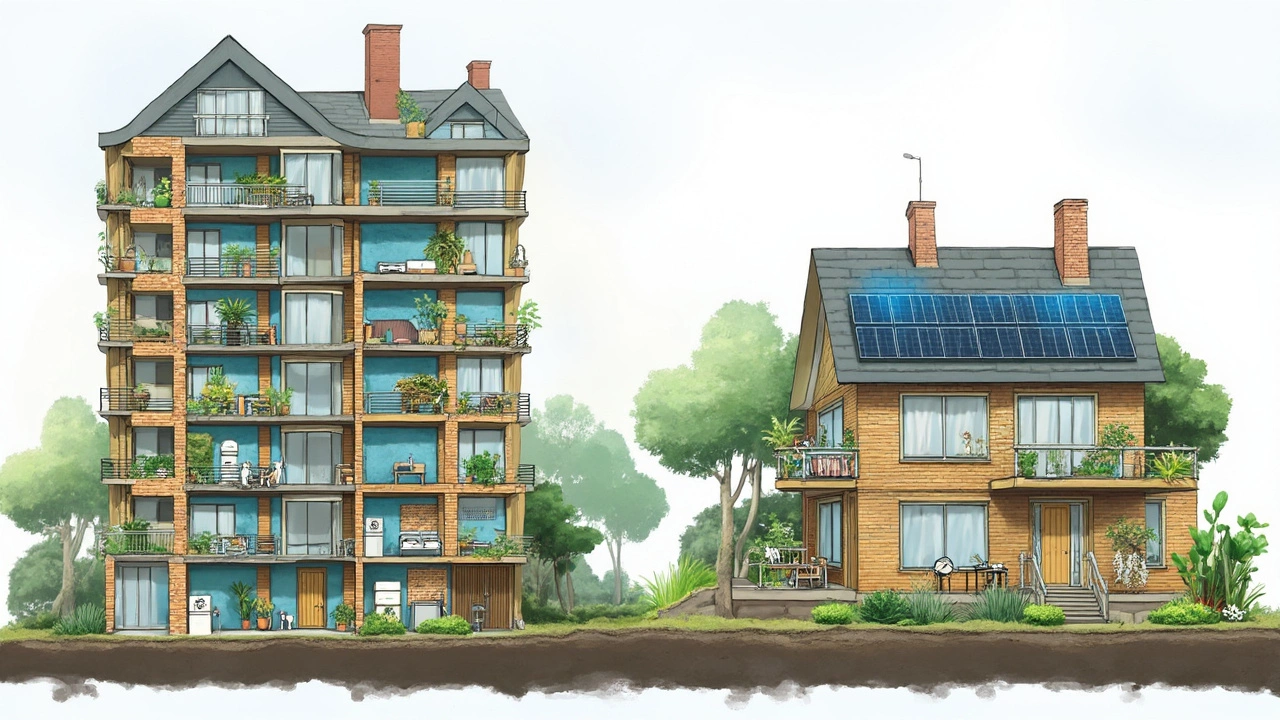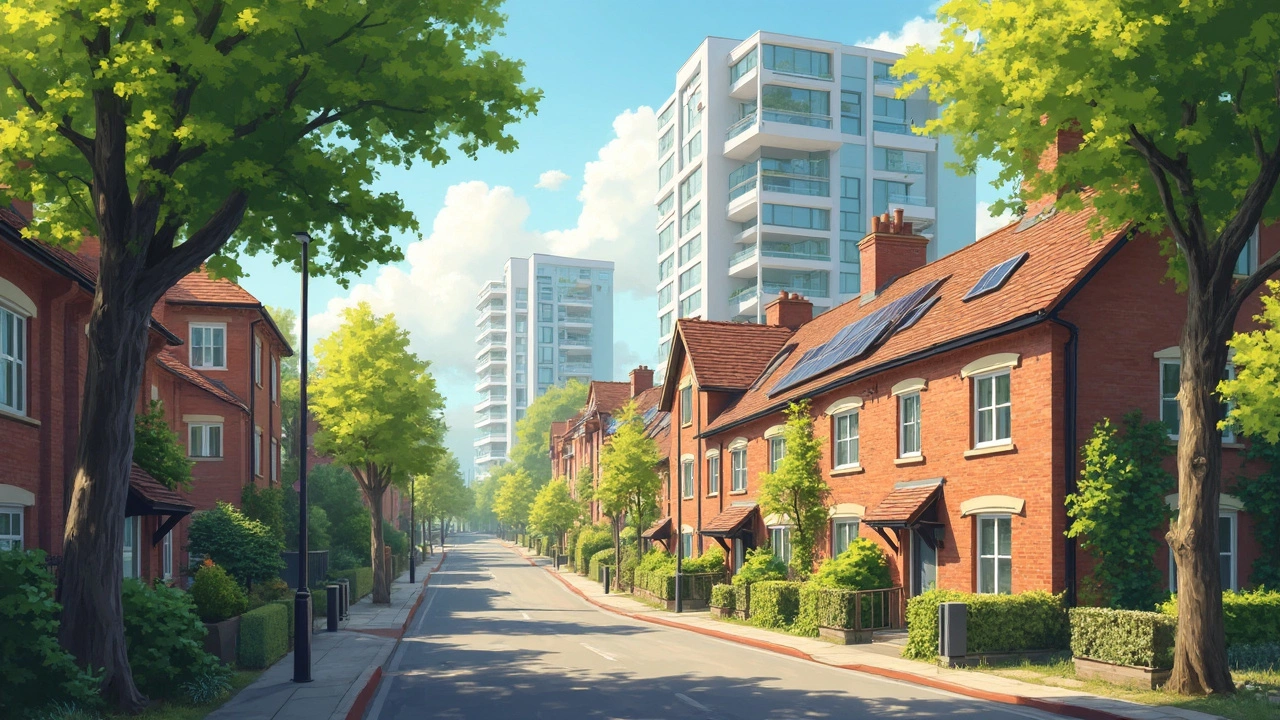So, you're trying to live a bit greener, and now you're wondering if planting roots in a house or an apartment makes more eco-sense. It's a real pickle, isn't it? Each choice has its ups and downs when it comes to the planet's health.
For starters, let's chat about energy use. Apartments often win here because you're snuggled up next to your neighbors. That means shared walls, less heat and cool air slipping out, and smaller spaces to light and warm. With houses, you've got more roof and wall space exposed, which might mean cranking up the thermostat more often.
But here's a plot twist: houses give you the chance to go big on eco upgrades, like slapping some solar panels on that big ol' roof, starting a compost heap, or growing your own veggies. Apartments can't quite compete on that front, especially if you're on the top floor with no backyard in sight.
- Energy Efficiency
- Water Consumption
- Green Space and Biodiversity
- Transportation and Accessibility
- Renovation and Eco Upgrades
- Community Impact
Energy Efficiency
When it comes to energy efficiency, life in an apartment often comes out ahead. Think about it – when your walls, ceilings, and floors are sandwiched between other units, it's like being wrapped in a cozy blanket, keeping all that warmth (or coolness) right where you want it. Less surface area means less energy waste. Imagine sharing body heat at a concert—your apartment's doing the same thing with your neighbor's heating!
In an apartment, you're usually heating or cooling a smaller space, which can lead to some serious savings on the energy front. That can mean lower utility bills, leaving you with more cash for, say, organic groceries or a nice eco-friendly getaway.
But if you're eyeing a house, don't despair! There are still ways to boost energy efficiency on a larger scale. Double-glazing windows, insulating attics, and investing in energy-efficient appliances can cut down on excess energy use. Plus, you can capitalize on the bigger space with solar panels. Here's a quick look at how solar energy could work for you:
- Initial Investment: Buying and installing solar panels can be pricey upfront, but it's a long-term game. Over time, the savings on your electricity bills could pay it off.
- Environmental Impact: Solar panels generate clean electricity, reducing your carbon footprint, which is a win for the planet.
- Energy Independence: Generate your own electricity and rely less on the grid. Plus, it’s pretty satisfying to tell folks you powered your own home.
So, whether you're counting steps in a small flat or kicking back in a spacious bungalow, there's a path to making your home more energy-efficient. Living sustainably might mean picking an option that aligns best with your lifestyle and commitment to being gently green.
Water Consumption
Water management is another biggie when choosing between a house and an apartment. It might surprise you, but eco-friendly living can look quite different depending on where you hang your hat.
In the apartment world, water is usually metered communally, which can be a good thing. It means folks might be more conscious of their usage, knowing that the whole building's numbers tend to reflect on everyone. Common amenities, like shared laundry rooms, might also lower the water footprint per person compared to homes where individual washers and dryers are the norm.
Houses, on the other hand, offer an opportunity for taking personal control over your sustainable home. You can install rainwater harvesting systems, low-flow fixtures, and even a greywater recycling setup if you’re into some serious green living. While that requires an upfront investment, it can hugely impact your water consumption. Plus, if you have a yard, using captured or recycled water for irrigation can save a ton of treated water.
Speaking of which, let’s talk outdoor water use. While apartments typically have minimal green space, large tracts of lawns in neighborhoods can become water-guzzlers, especially during the summer months. So, going for native or drought-tolerant landscaping can cut down on unnecessary watering significantly.
If you’re a numbers nerd, here's a quick look at typical water use:
| Living Space | Average Water Use (gallons/day/person) |
|---|---|
| Apartment | 50-70 |
| House | 100-120 |
These figures show that unless you’re taking active measures, houses might consume more water. The choice between an apartment and a house isn’t just about the space or prestige, it’s about how willing you are to adapt and take control of your water usage for an eco-friendlier lifestyle.
Green Space and Biodiversity
When it comes to green space, houses often seem like the obvious winner. You've got this whole patch of land to call your own, which is perfect for gardening or setting up a wildlife-friendly zone. Plus, planting trees and native plants in your yard can boost local biodiversity, attracting bees, birds, and butterflies to your garden.
But let's not completely write off apartments just yet. Some apartment complexes are making strides by incorporating shared gardens or community green spaces, giving everyone a chance to get their hands dirty. And rooftop gardens? They're popping up in cities all over, transforming once unused spaces into lush, productive areas.
While living in a house gives you direct control over your garden, communal spaces in apartment blocks encourage a sense of shared responsibility towards the environment. Plus, they can provide green relief in bustling urban areas where nature is often at a premium.
Here's something interesting: urban areas with more small green spaces, like those in well-planned apartment areas, can actually host a surprising amount of wildlife. It sounds wild, but even tiny plots or potted plants can support a decent chunk of urban biodiversity!
To wrap it up, whether you’re in a house or an apartment, there's potential to add to your neighborhood's green pulse. It's all about maximizing what you've got and perhaps getting a little creative with it.

Transportation and Accessibility
When it comes to eco-friendly living, how you get around is a big deal. Living in an apartment often means you're smack dab in the middle of the action, close to public transportation, groceries, and maybe even your job. This setup is a win for sustainability since you’re more likely to walk, bike, or hop on a bus instead of driving your car everywhere.
But what about when you choose to live in a house? Typically, these are spread out in suburban or rural areas where public transport might not be as handy. This generally means more driving, which can increase your carbon footprint. However, you can still make smart moves by carpooling or using a fuel-efficient vehicle. And hey, if you’re really dedicated, setting up a car-sharing community in your neighborhood could be a game-changer.
Let's look at a few simple ways to keep your transportation plan sustainable no matter where you live:
- Use public transportation whenever possible. Trains and buses often have routes through main roads, even in the suburbs.
- Consider walking or biking for short trips. It’s not just green; it's also great for your health.
- If driving is a must, opt for a hybrid or electric vehicle. Charging stations are becoming more common, even out in the sticks.
- Try working from home a couple of days a week if possible. Less commuting means less impact on the environment.
A fun fact for you: A study found urban living can cut transportation energy use by 30%! That’s because cities typically offer more options for getting around without needing a personal car.
Renovation and Eco Upgrades
When it comes to turning your living space into a green paradise, houses have more room—literally and figuratively. Owning a house means more control over sustainable homes changes, like adding energy-efficient windows or installing a new HVAC system that's kind to the environment. Think of it as a blank canvas for all your eco-friendly ambitions.
If you own a house, getting solar panels on your roof isn't just possible; it's often a stellar idea. They might cost a little up front, but the payback, both in money and clean energy, can make them worth every penny. Apartments, especially the rented ones, can be tricky. Installing panels on a shared roof isn't straightforward, requiring landlord permissions and sometimes, the whole building's buy-in.
For those with a bit of yard, big or small, rainwater harvesting can be a game changer. With a few barrels or a professional system, you can collect rain to water your garden or even flush your toilets. It's a nifty way to cut down on water consumption and save a few bucks on your water bill.
- Install energy-efficient appliances to save electricity.
- Consider eco-friendly insulation to maintain temperatures with less energy.
- Add a green roof or rooftop garden for better air quality and temperature control.
But hey, don't feel left out if you're in an apartment. You can still do your bit with eco-friendly living by using smart plugs to cut down vampire energy or choosing LED lighting. Apartments can even be great for indoor plants. Whether herbs in the kitchen or succulents by the window, they help clean the air and add to your eco footprint.
Community Impact
When pondering whether to dwell in a house or an apartment, don't sleep on how your choice impacts the community. It's a big deal, really!
Starting with apartments, these spots tend to build a sense of community naturally. With close neighbors and shared spaces like laundry rooms, gyms, or co-working areas, you're more likely to bump into folks frequently. This can foster strong bonds and communal efforts for shared recycling programs, energy-saving initiatives, or even community gardens.
On the flip side, living in a house often means more elbow room and sometimes a little more solitude. But the ripple effect on community impact is significant. Houses mean more infrastructure—think new roads, utility lines, and services—which can stress local resources. However, homeowners often have a greater say in local matters through neighbourhood associations or community meetings.
Plus, when it comes to community sustainability, houses offer opportunities for local food production and maybe even neighborhood swap events for locally sourced goods. Yet, increased urban sprawl from new housing developments can lead to more traffic and pollution, requiring thoughtful planning and eco-conscious community strategies.
Whether you're an apartment dweller or house owner, remember that your choice can kindle a positive or negative impact, not just on your <>sustainability goals, but also on those living around you. Consider not just how you'll live, but also how you'll contribute to making your community a better place.
